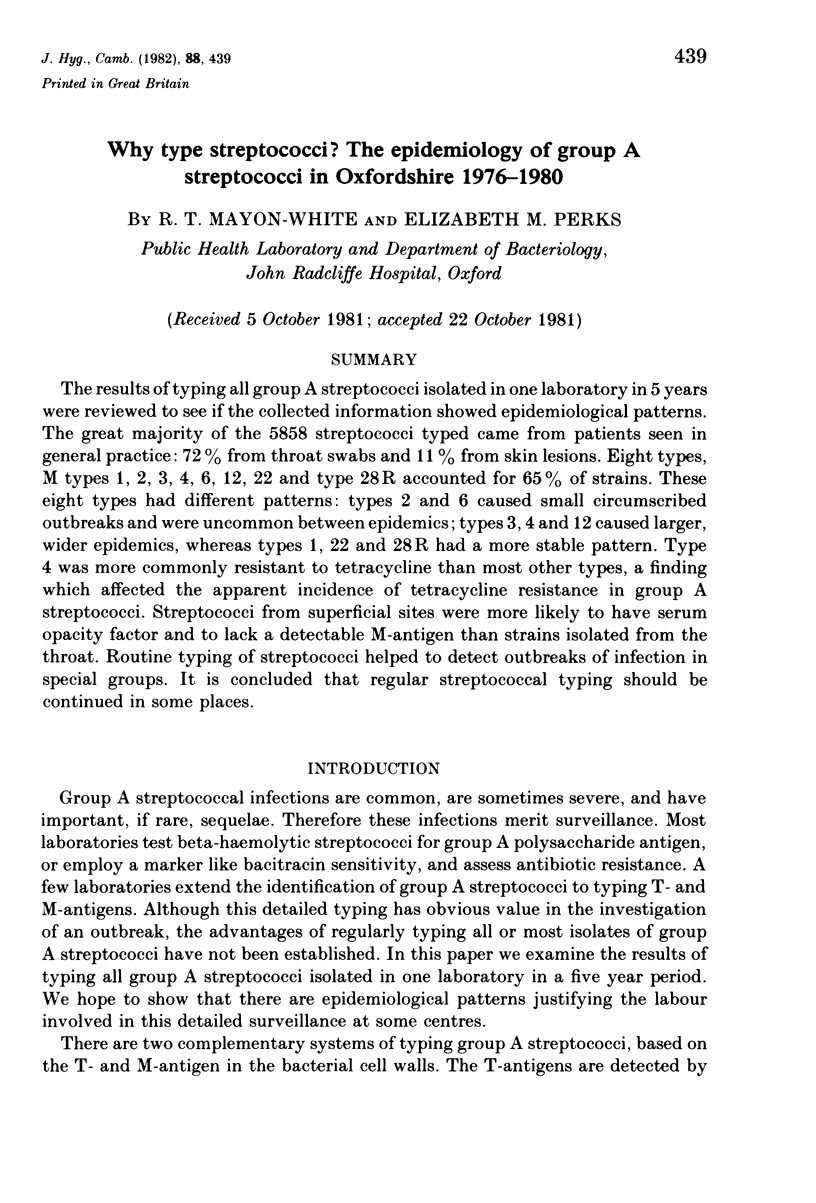Abstract
The results of typing all group A streptococci isolated in one laboratory in 5 years were reviewed to see if the collected information showed epidemiological patterns. The great majority of the 5858 streptococci typed came from patients seen in general practice: 72% from throat swabs and 11% from skin lesions. Eight types, M types 1, 2, 3, 4, 6, 12, 22 and type 28 R accounted for 65% of strains. These eight types had different patterns: types 2 and 6 caused small circumscribed outbreaks and were uncommon between epidemics; types 3, 4 and 12 caused larger, wider epidemics, whereas types 1, 22 and 28 R had a more stable pattern. Type 4 was more commonly resistant to tetracycline than most other types, a finding which affected the apparent incidence of tetracycline resistance in group A streptococci. Streptococci from superficial sites were more likely to have serum opacity factor and to lack a detectable M-antigen than strains isolated from the throat. Routine typing of streptococci helped to detect outbreaks of infection in special groups. It is concluded that regular streptococcal typing should be continued in some places.
Full text
PDF













Selected References
These references are in PubMed. This may not be the complete list of references from this article.
- Bergner-Rabinowitz S., Ferne M. Type distribution of beta-hemolytic streptococci in Israel: a 10-year study. J Infect Dis. 1978 Aug;138(2):152–159. doi: 10.1093/infdis/138.2.152. [DOI] [PubMed] [Google Scholar]
- Fraser C. A., Ball L. C., Morris C. A., Noah N. D. Serological characterization of group-A streptococci associated with skin sepsis in meat handlers. J Hyg (Lond) 1977 Apr;78(2):283–296. doi: 10.1017/s0022172400056175. [DOI] [PMC free article] [PubMed] [Google Scholar]
- Hope-Simpson R. E. Streptococcus pyogenes in the throat: a study in a small population, 1962-1975. J Hyg (Lond) 1981 Aug;87(1):109–129. doi: 10.1017/s0022172400069291. [DOI] [PMC free article] [PubMed] [Google Scholar]
- Parker M. T. International survey of the distribution of serotypes of Streptococcus pyogenes (group A streptococci). Bull World Health Organ. 1967;37(4):513–527. [PMC free article] [PubMed] [Google Scholar]
- Robertson M. H. Tetracycline-resistant beta-haemolytic streptococci in South-west Essex: decline and fall. Br Med J. 1973 Oct 13;4(5884):84–85. doi: 10.1136/bmj.4.5884.84. [DOI] [PMC free article] [PubMed] [Google Scholar]
- Rotta J., Krause R. M., Lancefield R. C., Everly W., Lackland H. New approaches for the laboratory recognition of M types of group A streptococci. J Exp Med. 1971 Nov 1;134(5):1298–1315. doi: 10.1084/jem.134.5.1298. [DOI] [PMC free article] [PubMed] [Google Scholar]
- Wannamaker L. W. Differences between streptococcal infections of the throat and of the skin (second of two parts). N Engl J Med. 1970 Jan 8;282(2):78–85. doi: 10.1056/NEJM197001082820206. [DOI] [PubMed] [Google Scholar]


